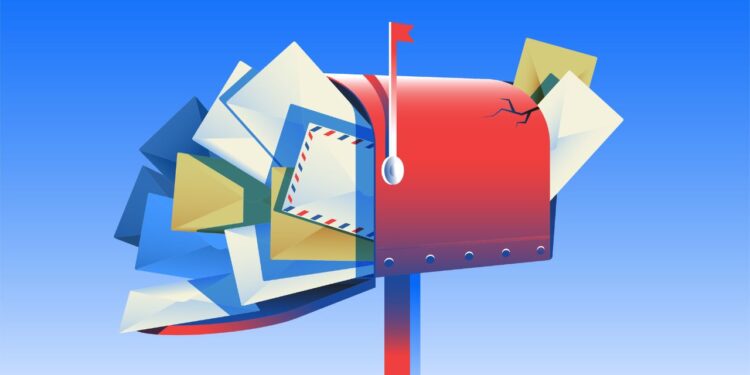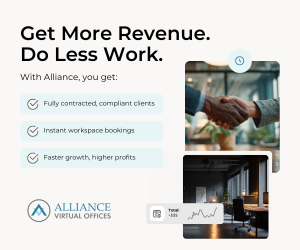- A well-structured mail process builds trust and long-term client relationships, reducing costly churn.
- Proactive mail notifications and addressing issues quickly create a positive experience that drives loyalty.
- Experts from Venture X, Barrister Executive Suites, and Createscape Coworking share their tried-and-tested best practices.
Experienced virtual office operators know that receiving and forwarding mail for clients isn’t just a daily box-checking exercise.
It’s a powerful service that adds revenue to your center.
How?
Business mail is important. Whether it’s a signed contract or a tax document, clients need their mail to run their business.
If they don’t receive their mail, your center gets the blame. That results in negative feedback, client walk-outs, and a poor reputation (even if it wasn’t your fault).
On the other hand, getting it right time after time instils confidence, builds client satisfaction, and leads to loyalty and long-term revenue.
It’s far more valuable to keep a happy client for the long-term than to face debilitating churn and constant acquisition costs — and for virtual office clients, a reliable, efficient and secure mail handling process is at the heart of it all.
We asked Carson Owen from Venture X (Greensboro, NC), Aubrey FitzGerald from Barrister Executive Suites (Woodland Hills, CA) and Keller Davis from Createscape Coworking (Austin, TX) to learn how it’s done.
What’s the Golden Rule of Mail Handling?
This one’s easy.
It’s about having an organized, trackable process that you not only stick to religiously, but keep fine-tuning until it’s completely watertight.
“Everything about efficient mail handling comes down to how you’ve organized your mail set up,” said Carson from Venture X Greensboro.
“Whether it’s color-coordination, a physical or digital ledger, or separate filing cabinets throughout your space, making sure you know where you’ve put the mail for who is imperative. Everything else falls into place after that.”
5 Ways to Build a Super-Efficient Mail Process
Organization is only part of a successful process. You also need space, tools, and flexibility to do the job right.
Here’s what else we learned from Carson, Aubrey, and Keller.
1. Create a dedicated mail sorting area.
“We have a dedicated mail area in the lobby. This separation is crucial for efficient sorting and minimizing mix-ups,” said Keller. “Since all mail is handled in one designated space, it’s easier to track and locate specific items.”
If you don’t have a secure space in your lobby or a purpose-built mailroom, consider converting a vacant office into a designated mail sorting space.
If you’re unsure about sacrificing an office, consider this: virtual offices represent nearly pure profit for centers and the inventory is limitless. In fact, virtual offices have the highest profit margin in the flex space industry.
So, keep in mind that an efficient, scalable virtual office operation could out-perform the revenue earned from a physical office — particularly if that space is vacant or difficult to fill.
Takeaways:
- Create a dedicated mail handling area to ensure organization and easy retrieval.
- Consider converting an under-performing office into a mailroom.
2. Keep it under lock and key.
Mailbox theft is on the rise and clients need to know their mail is safe. This goes for receipt, storage, and redistribution of mail.
“We use a locked building mailbox and locked filing cabinets. One set of keys stays on my person, the other is locked up in a third location,” said Carson.
At Aubrey’s center, “all mail remains securely locked until distributed” and anyone picking up mail must be on an approved list.
“Security is our top priority when handling mail. Our staff places a photo ID of the approved recipient in the corresponding mail slot, ensuring that mail is only released to authorized individuals.”
Keller added: “We store mail in a monitored, access-controlled area, and clients must check in at our visitor tablet when picking up mail.”
Takeaways:
- Store mail in locked cabinets or access-controlled spaces.
- Require ID verification or pre-approved recipient lists for mail pickup.
- Maintain secure storage and tracking logs to prevent unauthorized access.
3. Set up a process to quickly notify clients of delivered mail.
Clients are busy running and growing their business, and they don’t want to keep calling your center to find out if they’ve got mail.
You can dramatically improve client satisfaction and increase loyalty simply by notifying them when mail has arrived.
You can contact each client manually, or save time by taking advantage of existing mail notification tools.
Aubrey, along with other Barrister Executive Suites centers, use Delivered, a tool developed by Alliance to proactively notify clients that they have mail waiting.
“Using Delivered has helped our mail process tremendously,” said Aubrey. “It is so easy to notify clients of their mail now and it ensures mail doesn’t pile up.”
In addition, Aubrey’s team date the bottom corner of incoming mail on the day it arrives. “This helps track how long it has been in a tenant’s folder so we can reach out if it has been a while.”
At Createscape, Keller noted that dealing with mail promptly is key in staying organized and keeping clients happy.
“We process and categorize all incoming mail as soon as it arrives, ensuring virtual office members are notified quickly via email.”
Takeaways:
- Date-stamp incoming mail to track how long it has been in the system.
- Proactively notify clients immediately via email or an app to increase client satisfaction and prevent mail buildup.
4. Solve mail problems by getting to know your local postmaster.
Receiving mail for clients who moved out months ago is a regular occurrence for virtual office centers.
Typos are common, too, which often leads to misplaced or undelivered mail.
“The most common issue is clients not updating their forwarding addresses or providing incorrect details,” said Keller. “If mail is returned, we promptly notify the client and work to resolve it.”
While mail-related problems such as typos are outside a center’s control, you can help resolve it by maintaining a good relationship with your local USPS team.
“It is common for clients to forget to put a suite number on mail,” said Aubrey.
“Luckily, we have amazing USPS people who know our business and do their best to make sure we get all our clients’ mail, even if not addressed correctly.
“When this happens, we gently remind the client of the importance of including the suite number to ensure they receive all mail intended for them.”
Takeaways:
- Remind clients to use correct suite numbers to avoid misdirected mail.
- Proactively contact clients about returned or undeliverable mail.
- Get to know your local mail delivery team — they may be able to deliver mail to your center even if it’s not addressed correctly.
5. Watch out for unauthorized “clients.”
From time to time, you may receive mail for someone who isn’t — and has never been — a client.
Unauthorized use of center addresses is annoyingly common in our industry, and often, you won’t know it’s happening until you receive mail for a mystery client.
But you can still turn this into a revenue opportunity.
“At times, we receive mail addressed to individuals or businesses that are not ours,” said Aubrey. “When this happens, we check to see if they are advertising our address online. If so, we reach out to offer them the opportunity to sign up for one of our mail receiving packages.
“If they choose not to enroll in a mail service, we issue a Cease and Desist notice and return their mail to the sender. This ensures that our mail services remain exclusive to registered tenants.”
Takeaways:
- Offer non-clients the opportunity to sign up for a mail service.
- Track and return unauthorized mail with a Cease and Desist notice.
Plan for the Future — and for Success
“It’s important to have an adaptive, flexible system that allows for room to grow,” said Carson. “When you develop your system for mail organization, make sure you know how you will add the next ten, fifty, and one hundred clients.”
Providing you have a solid foundation in place with a reliable and efficient mail handling process, your center could manage dozens, even hundreds of virtual office clients (we know of one center in Las Vegas that has 1,600 virtual clients).
The more efficient your mail operations, the more virtual office clients you can serve — without adding physical space or overhead.
That’s why a slick, well-organized mail handling system isn’t just a necessity — it’s an opportunity to enhance client satisfaction, reduce churn, and drive long-term revenue.
Get it right, and your virtual office offering can become one of the most profitable services in your business.
This article was written by Mike Sullivan, Chief Marketing Officer for Alliance Virtual Offices.


 Dr. Gleb Tsipursky – The Office Whisperer
Dr. Gleb Tsipursky – The Office Whisperer Nirit Cohen – WorkFutures
Nirit Cohen – WorkFutures Angela Howard – Culture Expert
Angela Howard – Culture Expert Drew Jones – Design & Innovation
Drew Jones – Design & Innovation Jonathan Price – CRE & Flex Expert
Jonathan Price – CRE & Flex Expert










